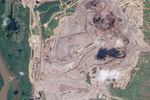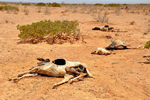China has unveiled details of its first pilot carbon-trading program, which will begin next month in the southern city of Shenzhen.
The trading scheme will cover 638 companies responsible for 38% of the city’s total emissions, the Shenzhen branch of the powerful National Development and Reform Commission (NDRC) announced on Wednesday. The scheme will eventually expand to include transportation, manufacturing and construction companies.
Shenzhen is one of seven designated areas in which the central government plans to roll out experimental carbon trading programs before 2014.
China is the world’s biggest carbon emitter and burns almost as much coal as the rest of the world’s countries combined.
Li Yan, Greenpeace east Asia’s climate and energy campaign manager, said that the pilot programs will inform the central government on how to motivate local authorities to adopt low-carbon policies.
The push to reduce carbon emissions coincides with the newly installed leadership’s effort to tackle the country’s dire air pollution problem, which has emerged as a source of widespread anger and frustration in recent months. “Having a mid-term strategy, and trying to prepare years ahead, is actually in line with China’s interests and its political and social priorities,” she said.
On Monday, the Chinese newspaper 21st Century Business Herald reported that the NDRC has discussed implementing a national system to control the intensity and volume of carbon emissions by 2020. The agency expects China to reach its carbon emissions peak by 2025, five years earlier than many recent estimates, according to unnamed sources quoted in the article.
At a recent climate change meeting, the agency “announced that it’s currently researching and calculating a timetable for the greenhouse gas emissions peak, and will vigorously strive to implement a total emissions control scheme during the ’13th five-year plan’ period (from 2016-2020),” the paper quoted a NDRC official, also unnamed, as saying.
“The NDRC is looking for a national cap, but nobody knows exactly when that is going to happen,” said Wu Changhua, greater China director of the Climate Group. “There’s still a lot of work to be done.”
The EU’s carbon trading scheme, the world’s largest, has suffered repeated setbacks in recent months. In April, MEPs voted against a proposed reform aimed to raise the price of carbon, which has been diluted by an overabundance of permits.

Lychee Park in Shenzhen.
Original Post:
China unveils details of pilot carbon-trading programme
Related articles
Scientists have reached an overwhelming consensus on human-caused climate change

(05/16/2013) Despite outsized media and political attention to climate change deniers, climate scientists long ago reached a consensus that not only is climate change occurring, but it’s largely due to human actions. A new study in Environmental Research Letters further strengthens this consensus: looking at 4,000 peer-reviewed papers researchers found that 97 percent of them supported anthropogenic (i.e. human caused) global warming. Climate change denialists, many of them linked to fossil fuel industries, have tried for years—and often successfully—to undercut action on mitigating climate change through carefully crafted misinformation campaigns.
Canadian government drops over $16 million on advertising its tar sands

(05/16/2013) The Canadian government has nearly doubled its advertising spending to promote the Alberta tar sands in an aggressive new lobbying push ahead of Thursday’s visit to New York by the prime minister, Stephen Harper. The Harper government has increased its advertising spending on the Alberta tar sands to $16.5m from $9m a year ago.
(05/15/2013) With islands and atolls scattered across the ocean, the small Pacific island states are among those most exposed to the effects of global warming: increasing acidity and rising sea level, more frequent natural disasters and damage to coral reefs. These micro-states, home to about 10 million people, are already paying for the environmental irresponsibility of the great powers.
Eat insects to mitigate deforestation and climate change

(05/14/2013) A new 200-page-report by the UN Food and Agriculture Organization (FAO) urges human society to utilize an often-ignored, protein-rich, and ubiquitous food source: insects. While many in the industrialized west might turn up their noses at the idea of eating insects, already around 2 billion people worldwide eat over 1,900 species of insect, according to the FAO. Expanding insect-eating, the authors argue, may be one way to combat rising food needs, environmental degradation, and climate change.
Mount Everest glaciers have shrunk 13% in 50 years
(05/13/2013) Glaciers in the Mount Everest region have shrunk by 13 percent and the snow-line has shifted 180 meters (590 feet) higher during the past 50 years, according to a study that will be presented this week at a conference organized by the American Geophysical Union.
Climate change to halve habitat for over 10,000 common species
(05/13/2013) Even as concentrations of carbon dioxide in the atmosphere hit 400 parts per million (ppm) for the first time in human history last week, a new study in Nature Climate Change warns that thousands of the world’s common species will suffer grave habitat loss under climate change.
Last time CO2 hit 400 ppm, temperature was 8C warmer, seas 40m higher than today
(05/12/2013) The future of a globally warmed world has been revealed in a remote meteorite crater in Siberia, where lake sediments recorded the strikingly balmy climate of the Arctic during the last period when greenhouse gas levels were as high as today.
A new world?: carbon dioxide concentrations in atmosphere hit 400 ppm

(05/11/2013) For the first time since homo sapiens evolved, concentrations of carbon dioxide in the atmosphere have struck 400 parts per million (ppm) due to burning fossil fuels. The National Oceanic and Atmospheric Administration (NOAA) reports that readings of carbon dioxide at Mauna Loa Observatory in Hawaii hit the symbolic number on Thursday and are expected to continue rising in coming years. The last time concentrations were this high for a sustained period was 4-5 million years ago when sea levels were 5-40 meters higher than today and the poles were 10 degrees Celsius hotter. During this epoch, forests grew along the shores of the Arctic Ocean and coral reefs were almost wholly absent.
Featured video: How climate change is messing with the jetstream
(05/08/2013) Weather patterns around the globe are getting weirder and weirder: heat waves and record snow storms in Spring, blasts of Arctic air followed by sudden summer, record deluges and then drought.
The Hawaiian silversword: another warning on climate change

(05/06/2013) The Hawaiian silversword (Argyroxyphium sandwicense), a beautiful, spiny plant from the volcanic Hawaiian highlands may not survive the ravages of climate change, according to a new study in Global Change Biology. An unmistakable plant, the silversword has long, sword-shaped leaves covered in silver hair and beautiful flowering stalks that may tower to a height of three meters.